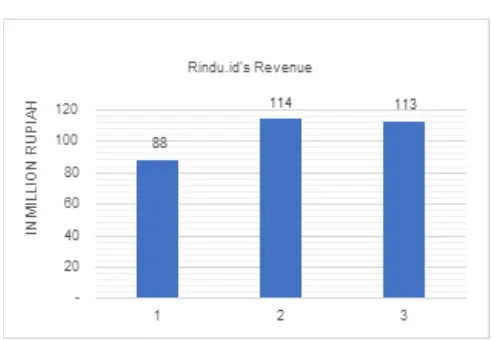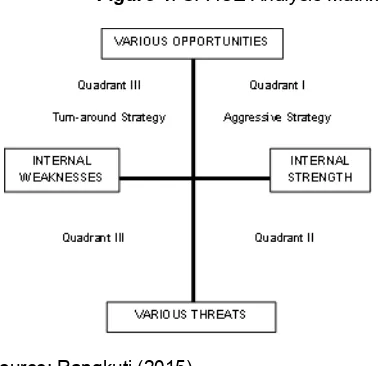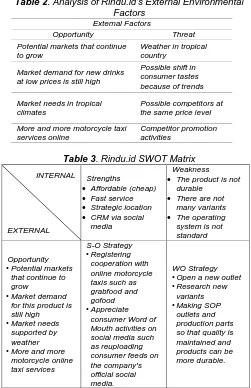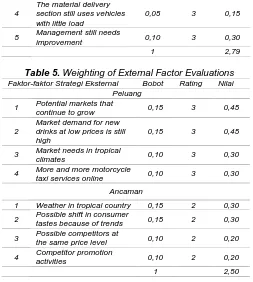4180
Product Sales Increase Strategy Through Product
Diversification And Market Penetration
Amalina Maryam Zakiyyah, Isti FadahAbstract :The growth of the F&B industry in Indonesia increases every year to reach 7-8%, even drinks can reach above 10%. This shows the high
demand for beverage products. This condition which is considered to be beneficial has encouraged many players to enter the industry. So, it takes a certain strategy to win this competition. The research aims to determine a strategy that is in line with internal and external factors of the company, in this case a case study in Rindu.id. To determine the strategy carried out by SWOT analysis and IE matrix. From the results of gathering and weighting Rindu.id's internal and external environmental factors, IFE values of 2.79 and EFE of 2.5 were found. From the results of the Space Analysis matrix, this organization is in quadrant I with an aggressive strategy of market penetration and product development. The results of plotting in the IE matrix show the results of the company are in quadrant V into the category of hold and maintain also with market penetration strategies and product development. Based on the similarity of the results, the strategy chosen by the company to win the competition is to expand the market and develop new products.
Keywords: External Factors, F&B Industry, Internal Factors, Marketing Strategy, Market Penetration, Produk Development, SWOT Analysis.
——————————
——————————
1.
INTRODUCTION
Indonesia as part of a developing country will have considerable needs especially in food, clothing, shelter, consumer electronics, household appliances, and many other items. This condition makes developing countries a potential market because of these needs [1]. With a large market - Indonesia's population of 267 million - and is included in the category of developing markets, so it is natural that the F&B industry is in great demand [2]. In a business portal it is even mentioned that the growth of the F&B industry in Indonesia annually increases above 7-8%. Meanwhile, specifically for the beverage industry itself, growth can reach above 10% [3]. This rapid growth shows the high market demand in this industry. This Indonesian market is starting to change the old mindset about food, especially drinks as part of entertainment (recreation). This opportunity was captured by many business people so that the market experienced significant growth. So it takes a strategy to be able to compete in this industry. Strategy is a series of decisions taken by managers in order to improve company performance relative to competitors. If the strategy implemented is capable of producing superior performance, then it can be called a company having a competitive advantage [5]. Whereas Proctor refers to strategy as a plan that combines the organization’s big goals, policies, decisions and actions or activities into an overall unity of the organization [6]. Strategies can be applied at all levels of management in each functional area. If in marketing, there will be pricing strategies, products, promotions, distribution, advertising, marketing research, etc. Rindu.id which also attended enlivened the trend of the F&B beverage industry, centered in the district of Jember, East Java. Rindu Indonesia is a culinary startup or food startup from Jember which serves cold Thai Tea, Milk and Chocolate cold drinks.
A very striking difference is in the naming of the menu offered. If generally the Thai Tea beverage business includes the name Thai Tea in its menu, not so with Rindu.id. For example the Green Tea menu changed its name to Fuji. So that the menu offered by Rindu.id is Taro, Chocolate, Fuji, Oriza and Jasmine Tea. Customers can add 3 toppings that have been provided, namely boba, mango and oreo. This business has been running since early August 2019 and already has 4 outlets. Sumatra street no. 122a, Mastrip street no. 72, Danau Toba street and Kreanova University of Jember. Rindu.id's revenue turnover has increased every period. This shows a good market acceptance of Rindu.id products and brands.
Figure 1. Rindu.id Revenue Data
Source: Processed data
In terms of sales data per product shows an increase in each product offered. It also shows such great market interest in Rindu.id products. Variants of products that have new tastes and unique names (Fuji and Oriza) are more in demand by the market than product variants with familiar flavors on the tongue of consumers (Jasmine).
____________________________________
Author name is lecturer in Muhammadiyah University of Jember, Email: amalinamaryam@unmuhjember.ac.id
Co-Author name a Professor and lecturer at Faculty of Economics and Business, University of Jember, Indonesia, E-mail:
Figure 2. Sales Data per Product
Source: Processed data
However, due to high competition in this industry, companies are required to be able to determine strategies in order to survive and develop in them. The purpose of this study is to determine strategies that are appropriate for internal and external factors of the company.
2. METHOD
This research uses a case study approach. Researchers conducted data mining on related objects and conducted interviews with company owners, managers and employees of this company [4]. Furthermore, the data obtained will be analyzed by SWOT analysis. SWOT analysis is often understood as an attempt to systematically identify internal and external factors to formulate a company's strategy. This analysis is based on efforts to maximize strengths and opportunities, but simultaneously also minimize weaknesses and threats [5]. The company's performance is strongly influenced by a combination of internal and external factors of the company. The two factors namely the company's internal and external environment always changes so it forces the company to determine its strategy in dealing with these changes. SWOT analysis compares external environmental factors consisting of opportunities and threats with internal environmental factors, namely the strengths and weaknesses of the company [5]. Analysis using the SWOT matrix helps managers to develop four types of strategies that result from crossing between internal strengths and weaknesses with external opportunities and challenges. The four strategies in question are: SO strategy (strength-opportunity), WO strategy (weakness-opportunity), ST strategy (strength-threat), and WT (weakness-threat) strategy. The SO strategy uses the company's internal strengths to maximize external opportunities. The WO strategy overcomes internal weaknesses by exploiting external opportunities. The ST strategy uses the company's strengths to avoid or reduce the impact of external threats. The WT strategy is a defensive tactic aimed at reducing internal weaknesses and avoiding environmental threats [6] [7]. Steps to carry out a SWOT analysis and create a SWOT matrix: identify key factors of company external opportunities and threats, then also identify key factors of the company's internal strengths
and weaknesses. The next step is to find a match between internal forces and external opportunities so that the SO strategy is generated in the appropriate cell. Then combining internal weaknesses with external opportunities into a WO strategy. Likewise looking for compatibility between internal forces and external threats, resulting in the ST strategy. Finally, it matches internal weaknesses with external threats, and produces a WT strategy.
Figure 3. SWOT Matrix
Strength (S) Weakness (W)
Opportunities (O)
DEVELOPMENT Use S to utilize O
IMPROVEMENT Utilize O to overcome W
Threat (T) STRENGTHENING
Use S to avoid T
CONSOLIDATION Minimize W to avoid
T Source: Rangkuti (2015)
According to Rangkuti, in addition to the SWOT matrix, analysis can also be done by weighting and ranking the SWOT factor so that it becomes an IFE (Internal Factors Evaluation) and EFE (External Factors Evaluation) matrix [5]. IFE and EFE matrix calculations are preceded by determining the weight of each factor with a range of values from 0 to 1 (not important to very important). Continue to scale the factors of 4 (very good), 3 (good), 2 (low) and 1 (very low). Then the factor weights are multiplied by the factor scale and add multiplication at this stage. The next stage calculates the difference in the amount in the previous stage between strengths (S) and weaknesses (W) and opportunities (O) and threats (T). The next stage connects the calculation points with graphs in the SWOT analysis so that the strategies that must be applied by the company are known [8]. In his book, David mentions the Space Analysis matrix [6], which can be used to determine strategies based on the IFE and EFE matrices.
Figure 4. SPACE Analysis Matrix
Source: Rangkuti (2015)
4182 is considered to have opportunities and strengths that
support aggressive growth.
Quadrant II: In this quadrant, the company is considered to face many threats but has internal strength to overcome them. The strategy adopted is to use the power to take advantage of opportunities by diversifying both products and markets.
Quadrant III: This quadrant indicates that the company faces a large market opportunity, but internal conditions are also facing problems or obstacles that require improvement. The strategy adopted is to focus efforts to improve and minimize weaknesses so as to seize market opportunities.
Quadrant IV: In this quadrant, the company is considered to be at a disadvantage because it faces various internal problems and external threats.
Internal External Matrices (IE) places the organization into nine different parts in the diagram [6]. IE Matrix is built based on two key factors namely the company's internal and external environmental factors. Both internal and external environmental factors are weighted and ranked (the result of weighting in the SWOT analysis). The result of weighting IFE becomes x-axis and EFE becomes y-axis from IE matrix.
Figure 5. Internal-External (IE) Matrix
Source: David (2011)
IE matrix consisting of nine parts can be divided into 3 different types of strategic decision categories. The first category has grow and build strategy located in Diagrams I, II and IV. The strategy offered is intensive which consists of market penetration, market development and product development. In addition, integrative strategies (backward integration, forward integration and horizontal integration are also offered). The second category lies in diagrams III, V, and VII that have a hold and maintain strategy. The strategies chosen in this category are market penetration and product development. The third category is called harvest and divest in the remaining diagrams, VI, VII, and IX. Liquidation, savings and divestment are the right strategies for this condition. Then David also mentioned that the best condition for an organization to succeed is to be around diagram I [6] [7].
3. RESULTS AND ANALYSIS
The SWOT analysis begins by identifying the organization’s internal environmental factors, namely the company's strengths and weaknesses. Furthermore, identification of organizational external environmental factors is carried out in terms of opportunities and challenges from outside the company. So we get the data as below:
Table 1. Rindu.id Internal Environmental Factor Analysis Internal factors
Strengths Weakness
Rindu.id offers a taste of the experience of Thai Tea at affordable prices and even cheap
Does not last long because it is mass produced
Rindu.id offers speed in service
There aren't many variants
Strategic outlet location Small outlets that are less convenient for consumers and employees Customer Relationship System
through "whatsapp marketing"
Rindu.id already uses the cashier software as a monitoring tool
The material delivery section still uses vehicles with little load Marketing system through
social media Instagram (giveaway)
Management still needs improvement
Table 2. Analysis of Rindu.id's External Environmental Factors
External Factors
Opportunity Threat
Potential markets that continue to grow
Weather in tropical country
Market demand for new drinks at low prices is still high
Possible shift in consumer tastes because of trends
Market needs in tropical climates
Possible competitors at the same price level
More and more motorcycle taxi services online
Competitor promotion activities
Table 3. Rindu.id SWOT Matrix
INTERNAL
EXTERNAL
Strengths
Affordable (cheap) Fast service Strategic location CRM via social
media
Weakness The product is not
durable There are not
many variants The operating system is not standard
Opportunity •Potential markets
that continue to grow
•Market demand for this product is still high •Market needs
supported by weather •More and more
motorcycle online taxi services S-O Strategy •Registering cooperation with online motorcycle taxis such as grabfood and gofood •Appreciate
consumer Word of Mouth activities on social media such as reuploading consumer feeds on the company's official social media.
WO Strategy •Open a new outlet •Research new
variants •Making SOP
Threat •Weather in the
rainy season •A shift in
consumer tastes due to trends •Competitors at
the same price level
•Competitor promotion activities
S-T Strategy •Hold sales
promotions in the form of discounts and bundling packages (buy 1 get 1 free) •Look for new
promotional channels
WT Strategy •Conduct R&D to
improve product durability •Conduct market
research related to competitors and consumers on an ongoing basis
The SWOT matrix yields four strategies. First the S-O strategy that seeks to maximize the opportunities that exist with internal strength. The S-O strategy is carried out by opening new markets through partnerships with online motorcycle taxi service providers (grabfood and gofood). Then also appreciate the e-WoM activities carried out by customers more massive. The second strategy produced by the SWOT matrix is W-O, which is minimizing weaknesses to win opportunities. The W-O strategy that can be done is to open new outlets so that they can reach more potential customers. Doing product research so that new variants are produced to avoid the customer's feeling of saturation. Then also set a standard production SOP so that product quality is maintained. The third strategy is S-T that is minimizing threats or challenges with the strength they have. In this strategy it is recommended to hold a sales promotion to boost product sales. Then it is also advisable to look for new promotional channels in addition to existing channels through Instagram. The fourth W-T strategy is to minimize weaknesses by minimizing threats. Weaknesses in the form of non-durable products can be overcome by conducting R&D for the end products can be more durable. Furthermore, for the threat of competitors and consumer trends, companies can continue to conduct market research related to competitors and target consumers.
Table 4. Weighting of Internal Factor Evaluations
Internal strategy factors Weight Rating Score
Strenghts
1
Rindu.id offers a taste of the experience of Thai Tea at affordable prices and even cheap
0,13 4 0,52
2 Rindu.id offers speed in
service 0,10 2 0,20
3 Strategic outlet location 0,10 3 0,30
4
Rindu.id already uses the cashier software as a monitoring tool
0,07 3 0,21
5
Marketing system through social media Instagram (giveaway)
0,10 3 0,30
6
Customer Relationship System through "whatsapp gateaway"
0,11 3 0,33
Weakness
1
Does not last long because it is mass produced
0,10 2 0,20
2 There aren't many
variants 0,10 2 0,20
3
Small outlets that are less convenient for consumers and employees
0,04 2 0,08
4
The material delivery section still uses vehicles with little load
0,05 3 0,15
5 Management still needs
improvement 0,10 3 0,30
1 2,79
Table 5. Weighting of External Factor Evaluations
Faktor-faktor Strategi Eksternal Bobot Rating Nilai
Peluang
1 Potential markets that
continue to grow 0,15 3 0,45
2
Market demand for new drinks at low prices is still high
0,15 3 0,45
3 Market needs in tropical climates 0,10 3 0,30
4 More and more motorcycle
taxi services online 0,10 3 0,30
Ancaman
1 Weather in tropical country 0,15 2 0,30
2 Possible shift in consumer
tastes because of trends 0,15 2 0,30
3 Possible competitors at
the same price level 0,10 2 0,20
4 Competitor promotion
activities 0,10 2 0,20
1 2,50
Then the results of the weighting above are entered in the Space Analysis Matrix with the four quadrants below:
Figure 6. Space Analysis Matrix
The Space Analysis matrix above shows that Rindu.id is in quadrant I with aggressive strategies [5]. The results of the weighting and ranking of IFE and EFE are in this quadrant, so the company is considered to have good conditions and supports aggressive growth. In David [6], it is stated that aggressive strategies are market penetration, market development, product development and diversification. Furthermore, the results of weighting IFE and EFE are included in the Internal and External matrix as follows:
4184 The calculation result for IFE is 2.79 while for EFE is 2.5 so
that after being included in the IE matrix shown in the picture above, it is in position V with a hold and maintain strategy. The strategy developed is a market penetration strategy and product development.
4. CONCLUSION
High competition in the beverage industry forces industry players to always be open-minded to change and make introspection. In this case, SWOT analysis is the most reliable tool for this purpose. The results of the SWOT analysis both through the SWOT matrix, then the Space Analysis matrix and the IE matrix both show that companies need to do market penetration strategies and product development. More detailed discussion of market penetration, taken based on the SWOT matrix. The company penetrates the online market by cooperating with online motorcycle taxi such as grabfood and gofood, as well as opening new outlets. To improve CRM in order to maintain market lucidity, companies need to increase the appreciation of e-WoM on social media such as reuploading consumer feeds on the company's official social media. Hold sales promotions in the form of discounts and bundling packages (buy 1 get 1 free). Looking for new promotional channels. Product development strategy needs to be done because there are not many menu variants and products cannot be stored for a long time. Based on the SWOT matrix, companies are advised to continue to develop new products, and find new ways of production through R&D.
5. REFERENSI
[1] P. Kotler and K. L. Keller, Manajemen Pemasaran, 13th ed. Pearson Education, 2009. [2] A. S. Fachrezzy, ―Indonesia Surga Bisnis Food
dan Beverage Halaman all - Kompasiana.com,‖ 2019.
[3] detikcom, ―Manisnya Bisnis Boba, 3 Ribu Gelas Ludes/Hari,‖ 2019. [Online]. Available:
https://finance.detik.com/berita-ekonomi- bisnis/d-4761449/manisnya-bisnis-boba-3-ribu-gelas-ludeshari. [Accessed: 18-Nov-2019]. [4] S. Candra and Linda, ―QSPM and 7C’s strategy
for e-SCM implementation strategy (case study: XYZ plastic corporation),‖ Int. J. Multimed. Ubiquitous Eng., vol. 9, no. 1, pp. 11–18, 2014. [5] F. Rangkuti, ―Teknik membedah kasus bisnis
Analisis SWOT,‖ Jakarta PT Gramedia Pustaka Utama, 2015.
[6] F. R. David, Strategic Management Concepts and Cases, 13th ed. New Jersey: Pearson Education, 2011.
[7] N. G. Torlak, ―David’s Strategy Formulation Framework in Action: The Example of Turkish Airlines on Domestic Air Transportation,‖ İstanbul Ticaret Üniversitesi Fen Bilim. Derg., vol. 6, no. 12, pp. 81-114–114, 2007.



